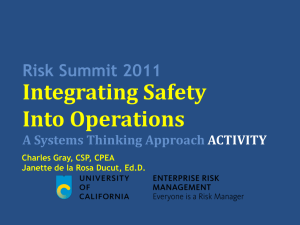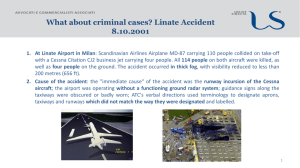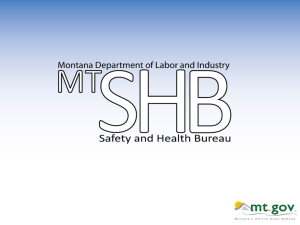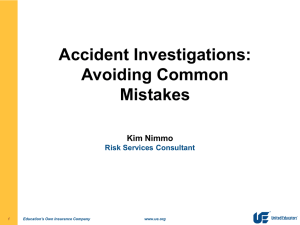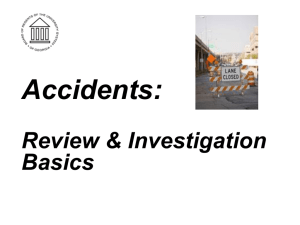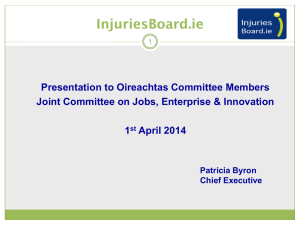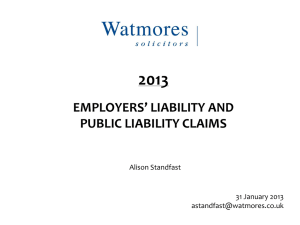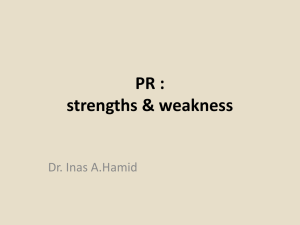Accident Investigation - McNeese State University
advertisement
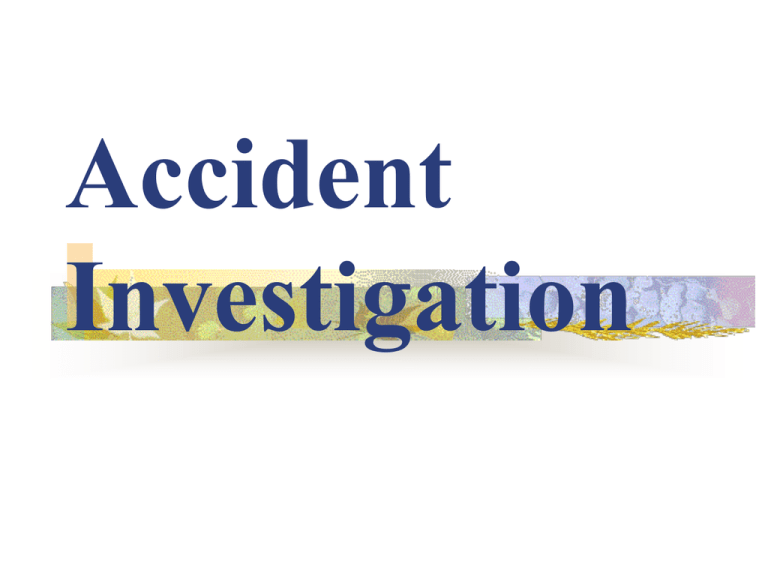
Accident Investigation Objectives Explain the meaning and impact of accidents Identify different types of accident causes Know the purpose of accident investigation Explain how to conduct an accident investigation Know how to document accident investigations. What is an Accident? Unplanned event results in mishap (personal injury or property damage). Accidents are the result of the failure of people, equipment, materials, or environment to react as expected. All accidents have consequences or outcomes. Purpose of Accident Investigation Determine the sequences of events leading to failure. Identify the cause of the accident. Find methods to prevent accident from recurring. Consequences of Accidents Direct Consequences 1. 2. Personal injury Property loss Indirect Consequences 1. 2. 3. 4. Lost income Medical expenses Time to retrain another person Decreased employee moral Types of Causes Basic Causes Poor Management Safety Policy & Decisions Personal Factors/Environmental Factors Unsafe Act Performance Indirect Causes Unplanned release of energy (Direct Cause) Conditions ACCIDENT Personal Injury Property Damage Examples of Accident Causes Direct Causes Indirect Causes Struck by/against Falls Failure to secure No oversight Caught in/between Exertion Improper use Guarding Basic Causes Poor maintenance. Training Unsafe position Policies Contact with…. Environmental Stress Impact (vehicle) Defect Engineering Be Prepared Develop a policy for accident investigation Routinely audit your policy to: - ensure personnel understand their role - system is driving corrective actions Assign responsibilities to personnel: - employee must be trained to investigate - investigator should know process Conducting the Investigation Interview witnesses. Document the accident scene before any changes are made. Review all information (procedures, equipment manuals). Conducting the Investigation Make documented observations on: Pre-accident conditions Accident sequence Post-accident conditions Document the facts (i.e.: location, witness remarks, and contributing factors). Determine sequence of events leading to accident Common Problem Solving Methods Job Hazard analysis Sequence diagrams Change analysis Job Hazard Analysis Steps Hazards Causes Control Measures Change Analysis A change analysis consists of: Defining the problem Establishing the norm Identifying, locating, and describing the change Identify what was affected and not affected List features of change Pick likely causes Witness Interviews Interview promptly. Establish rapport with witness (treat as equal). Get the facts. Write down the witness’s statement Documentation Complete an accident investigation form to collect: Personnel information Accident information (location, events leading to accident, machines involved) Causes of the accident Recommendation to prevent accident Follow up information Documentation From the accident investigation form and witness statements write an accident investigation report. The report should include: Background information (where, who) Summary (sequence, extent, type, source) Analysis (causes) Recommendations Steps to Accident Investigation Survey the scene Secure the scene (initiate interim controls) Get help for the injured Collect evidence Analyze data Determine causes (scientific methods) Follow up (eliminate hazards) Drug Testing In accordance with Governor Kathleen Blanco’s Executive Order KBB 2005-8, Drug Testing is conducted in accordance with the State of Louisiana rules and regulations for such. Positions subject to drug testing: All current W-2 employees in safety-sensitive or security-sensitive positions are subject to drug testing. The policy also applies to all persons who have made written application for positions designated as safety-sensitive and/or security-sensitive or who are promoted into a position that is considered safety-sensitive and/or security-sensitive. All current W-2 employees are subject to drug testing under the following conditions: reasonable suspicion, post-accident, and random testing as part of a monitoring program established to assure compliance with the terms of a rehabilitation agreement. Drug Testing Conditions when employer may test employees for drugs under State law: Pre-employment post-hire: The prospective employee hired for a safety-sensitive and/or security-sensitive position must undergo controlled substance drug testing prior to being placed in the position. Post-accident: An employee shall be tested following an accident during the course and scope of employment if there is reasonable suspicion of an employee’s drug use or if the accident results in: injury requiring medical treatment to any party involved or injury which results in a fatality; property/equipment damage at or above $1,000.00 and/or; the release of hazardous waste as defined in R.S. 30:2173(2) or hazardous materials. Responsibilities in Accidents/Injuries Employee Report injury/illness to supervisor immediately. Report in person to Human Resources as soon as possible unless there is a medical emergency or life/limb emergency. Report to Human Resources as soon as possible after emergency treatment. Complete proper paperwork for the Office of Risk Management/Drug Testing (if required) in Human Resources before seeking medical assistance unless there is a medical emergency or a life/limb emergency. Report any lost time from work to supervisor and to Human Resources. Return to regular duty by physician certification or transitional modified duty that is within medical restrictions (if any) as set by physician, as part of a rehabilitation program if applicable to position, and as approved by appropriate university personnel Supervisor Complete Incident/Accident Investigation Form, conduct investigation, and submit the original form to Human Resources. Maintain a copy in department. Contact Human Resources for further instruction or accompany injured/ill worker to Human Resources as supervisor signature may be required on certain documents. Maintain contact with injured/ill worker for updates to condition. Find or develop transitional modified duty for employee with restrictions, if applicable, as directed by the Director of Human Resources and the Safety Officer.

